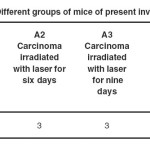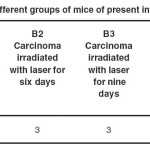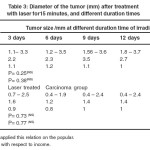Low Level Laser effect on the Action of Lymph Nodule and Cervical in Inoculated Mice with Carcinoma in Memory Gland
Aida Z. Al Kaissy and Isam Hussain T. Al-Karkhi*
Department of Basic Science/Collage of dentistry, University of Baghdad, Iraq
DOI : http://dx.doi.org/10.13005/ojc/290358
Article Received on :
Article Accepted on :
Article Published : 28 Oct 2013
Biological responses of cells to visible and near IR laser radiation occur due to physical and / or chemical changes in photo acceptor molecules, component of respiratory chains in mitochondria. As result of the photo excitation of electronic states, the follows of physical and /or chemical changes can occurs alteration of redox properties and acceleration of electron transfer, changes in biochemical activity due to local transient heating of chromospheres. Different reaction channels can be activated to achieve the photo biological macro effects. The aim of the study was: 1- to evaluate the effect of low level laser therapy (LLLT) on increasing the response of immune system by stimulating the lymph nodules action in order to inhabit cancer cells activity which leads to decrease the tumor size in diseased mice without using drugs. 2-to verify the effect of Low Level Laser (LLL) on the lymph nodules bio stimulation in case of disease by using different duration times with at the same area in each irradiation with the same power densities.
KEYWORDS:cervical lymph;gland carcinoma;LLL
Download this article as:| Copy the following to cite this article: Al Kaissy A. Z, Al-Karkhi I. H. T. Low Level Laser effect on the Action of Lymph Nodule and Cervical in Inoculated Mice with Carcinoma in Memory Gland. Orient J Chem 2013;29(3). doi : http://dx.doi.org/10.13005/ojc/290358 |
| Copy the following to cite this URL: Al Kaissy A. Z, Al-Karkhi I. H. T. Low Level Laser effect on the Action of Lymph Nodule and Cervical in Inoculated Mice with Carcinoma in Memory Gland. Orient J Chem 2013;29(3). Available from: http://www.orientjchem.org/?p=378 |
Introduction
The laser was recently become extremely important both in medicine and another medical applications, soft laser have been used to achieve very precise therapeutic effects for bio stimulation cells analgesic effects and anti-inflammatory effects(1). Cell biostimulation proved by soft lasers is reflected through the formation of the following mechanisms reduction of cellular cariokynesis time which leads to faster wound healing, the increase of cellular ATP so that the potential cell energy is increased stimulation of intra and extra cellular fluid ions which supports bipolarization and then helps cellular exchange, stimulation of specific cellular elements depending on, their absorption potential regarding some wavelength (2, 3).All of these mechanisms of stimulation and regulation produce effects which favor wound healing and swelling reduction which leads to total improvement of both arterioveral and lymphatic nutrition and microcirculation(4).Low level laser therapy (LLLT) has been used successfully in iomedicine and some of the results are thought to be related to cell proliferation. The effect of LLLT on cell proliferation is debatable because studies have found both an increase and a decrease in proliferation of cell cultures. Cell culture is an excellent method to assess both effects and dose of treatment (3). In both soft tissue and connective tissue injuries, LLLT can increase the final tensile strength of the healed tissue. By increasing the amount of collagen/ production synthesis and by increasing the intra and inter-molecular hydrogen bonding in the collagen molecules, laser therapy contributes to improve tensile strength (5). LLLT has proved to be effective in treating and repairing biologically damaged tissue and to reduce pain. and also proven to be an efficient method for the prevention of oral mucositis (6).
Several applications of lasers in clinical procedures for dental hard tissues are either currently in practice or being developed since newer wavelengths as well as different methods and delivery systems are being applied in the field of dentistry.
In endodontic therapy lasers have been used as treatment coadjutant with reference to both, low intensity laser therapy (LILT) and high intensity laser treatment (HILT) to increase the success rate of the clinical procedures. Low intensity laser therapy has the ability to produce analgesic,anti-inflammatory and bio modulation effects on the irradiated soft tissue thereby improving the wound healing process and giving the patient a better condition of the postoperative experience (7).
Material and Method
Thirty mice were randomly assigned to two groups A,B each of fifteen mice , female , 60 days age , 25gm main weight transplanted with cancer, subjects transplanted with mammary gland carcinoma in the Iraqi center of Cancer Research and Medical Genetic.These two groups were sub grouped into five groups three mice each A- This group contains of 15 subjects irradiated by laser of Ga- Ar (Gallium- Arsenide) of wavelength 905nm with power densities of 905 nm/cm2 and different exposure times as show in table (1) scarified in the day 3, 6, 9, 12 and 15 after the10 days of success inoculation (appearance of the tumor).
 |
Table 1: Different groups of mice of present investigation Click here to View table |
B- Control group this group contains of 15 subjects (negative laser) scarified in the day 3,6, 9,12 and 15 after the10 days of success inoculation ( appearance of the tumor) also as show in table (2). The lymph node of each scarified animals of group A and B were taken for histopathology examination.
 |
Table (2): Different groups of mice of present investigation Click here to View table |
Result and Discussion
Cell biostimulation provide by soft laser or Low Level Laser(LLL) is reflected through the stimulation of specific cellular elements (1). Compromised cells and tissues respond more readily than healthy cells or tissues to energy transfers that occur between LLL and the cells (2).
LLL emitted photons and the receptive chromospheres that founded in the various cells and sub cellular organelles absorbed this photons stimulate the node activity especially the syntheses of plasma and macrophage cells(3,4,5).The increasing that occurs in the plasma cells that found in the lymph nodules that taken from the animal after laser radiation .In the case of cancer the laser increase both vascular and cellular events (6) and injury responsive components such as Mast cells, Bradykinis and Prostaglandins with vascular responses and cell membrane reactions(7,8,9).
All these response increase the syntheses of macrophage and plasma cells that attacked the cancer cells (10) and increase the defiance of the body, also by increasing the production of ATP that enhanced significantly by laser that stimulate the cryotron C Oxidase (11), a chromosphere that found in the mitochondria of the cells that play a major role in this stimulation (12, 13, 14).
The increasing of the immune response resulting in the decreasing /limiting the size of the tumor that measured before and after laser irradiation.
 |
Table 3: Diameter of the tumor (mm) after treatment with laser for15 minutes, and different duration times. Click here to View table |
From this study we can conclude that soft laser displayed important rule in both faster healing especially in the early stage of the cancer in many locations as this study show, and in activation of the immune blast cells founded in the lymph nodes numbering the cancers locations to stimulate the defiance system to damaged/or to limit the increasing of the tumor growth as show in table (3)
References
- Absten GT , joffe S N . Lasers in medicine (an introductory guide). 2001.29(2): 179-184.
- Agaiby A D, chali L R, Wilson R, Dyson M. Laser modulation of angiogenic factor production by T-lymphocytes. Laser Surg. Med. 2000; 26(4): 357-63.
- Ahmed M. AL-Shamery, Nahi Y. Yassin, and Mohamed J. Alwan #Iraqi center for cancer and medical genetic research, Baghdad, Iraq # Baghdad university, college of veterinary medicine Department of pathology.
- Bleakley M, R IDDELL SR: molecules and Mechanisms of the graft – versus – leukaemia effect – Nat Rev cancer 4: 371, 2004.
- Alberts B, Johnson A, Lewis J: Molecular Biology of the Cell. New York: Garland science, 2002.
- Antonio L, ,Biomodulatory effects of LLLT on bone regeneration . The Journal of LaserTherapy . Vol . 13 . World Association of Laser Therapy .2000.
- Basford J R. Laser therapy: Scientific basis and clinical role Orthopedics. 19993; 16:541.
- Catone G A, Alling CC. Laser application in Oral and Maxillofacial surgery: Introduction in “Laser application in Oral and Maxillofacial surgery “edited by caton G A and Alling CC .1st ed. W.B.saunders company. Pennsylvania. 1997: pag: 1-4.
- Haldey J, Young D A, Eveisole L R, Gornbein J A. A Laser – powered hydrokinetic system for caries removal and cavity preparation. J. A.M. Dent. Assoc. 2000 Jun; 131 (6): 777-83.
- 10. Karu TI . Mechanisms of low – power laser light action on cellular level. In Laser in Medicine and Dentistry. Ed. by Z. Simunovic. Rijeka. Vitgraph .2000.pp.97-125.
- 11. Karu T. Primary and secondary mechanisms of action of visible to near –IR radiation on cells. J. photochem. Photobiol. B. 1999 Mar; 49(1): 1-17
- 12. Giller J P, Vinciguerra M, Heller A, Kunken F R, Kahn E. Treatment of gingival crohn’s disease with laser therapy. N. Y. state. Dent. J. 1997 May; 63(5): 32-5.
- 13. Goharkhay K, Moritz A, Wilder S, schoop U, Kluger W, Jakolitsch S, Sperr W. Effects on oral soft tissue produced by a diode laser in vitro. Lasers. Surg. Med. 1999; 25(5): 401-6.
- 14. Markolf , H. N. Laser tissue interaction .Heidelberg , Germany 1996.
- 15. Christopher M. Lasers in dentistry: A review. Part 2: Diagnosis, treatment and Research.Dental up date. 1996 April; 120-124.

This work is licensed under a Creative Commons Attribution 4.0 International License.









